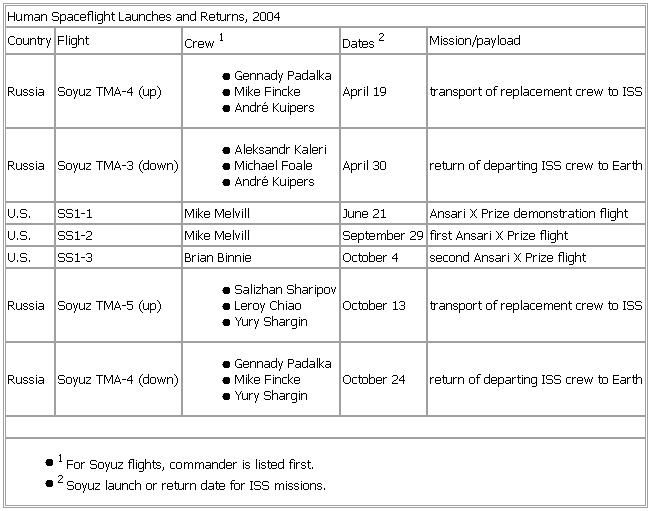Human Spaceflight Launches and Returns, 2004
- Human Spaceflight Launches and Returns, 2004
-
Human Spaceflight Launches and Returns, 2004
Country Flight Crew1 Dates2 Mission/payload
● Gennady Padalka
● Mike Fincke
● André Kuipers
April 19 transport of replacement crew to ISS
Russia Soyuz TMA-
3 (
down)
● Aleksandr Kaleri
● Michael Foale
● André Kuipers
April 30 return of departing ISS crew to Earth
U.S. SS1-1 Mike Melvill June 21 Ansari X Prize demonstration flight
U.S. SS1-2 Mike Melvill September 29 first Ansari X Prize flight
U.S. SS1-3 Brian Binnie October 4 second Ansari X Prize flight
● Salizhan Sharipov
● Leroy Chiao
● Yury Shargin
October 13 transport of replacement crew to ISS
Russia Soyuz TMA-
4 (
down)
● Gennady Padalka
● Mike Fincke
● Yury Shargin
October 24 return of departing ISS crew to Earth
● 1For Soyuz flights, commander is listed first.
● 2Soyuz launch or return date for ISS missions.
See as table:
* * *
Universalium.
2010.
Look at other dictionaries:
Spaceflight — For the magazine published by the British Interplanetary Society, see Spaceflight (magazine). For the 1985 PBS documentary series narrated by Martin Sheen, see Spaceflight (TV series). For the Sam Lazar album, see Space Flight (album). Part of a… … Wikipedia
Physical Sciences — ▪ 2009 Introduction Scientists discovered a new family of superconducting materials and obtained unique images of individual hydrogen atoms and of a multiple exoplanet system. Europe completed the Large Hadron Collider, and China and India took… … Universalium
September 2004 — NOTOC September 2004 : January February March April May June July August September October November December See also: September 2004 in sportsEventsSeptember 1, 2004* Alu Alkhanov is confirmed as the winner of the presidential election in… … Wikipedia
Timeline of artificial satellites and space probes — This Timeline of artificial satellites and space probes includes unmanned spacecraft including technology demonstrators, observatories, lunar probes, and interplanetary probes. First satellites from each country are included. Not inclued are… … Wikipedia
space exploration — Investigation of the universe beyond Earth s atmosphere by means of manned and unmanned spacecraft. Study of the use of rockets for spaceflight began early in the 20th century. Germany s research on rocket propulsion in the 1930s led to… … Universalium
Space Race — For a discussion of all spaceflight programs to date, see History of spaceflight. For a list of key events, see Timeline of space exploration. For other uses of the term, see Space Race (disambiguation). A replica of Sputnik 1, the world s… … Wikipedia
Mir — This article is about the Soviet/Russian space station. For other uses, see Mir (disambiguation). Mir … Wikipedia
Hayabusa — This article is about the spacecraft. For other uses, see Hayabusa (disambiguation). Hayabusa A computer rendering of Hayabusa above Itokawa s surface Operator … Wikipedia
Constellation program — logo Constellation Program (abbreviated CxP) is a human spaceflight program within NASA, the space agency of the United States. The stated goals of the program were to gain significant experience in operating away from Earth s environment,… … Wikipedia
Spacecraft — Spaceship redirects here. For other uses, see Spaceship (disambiguation). More than 100 Russian Soyuz manned spacecraft (TMA version shown) have flown since 1967, originally for a Soviet manned lunar program, but currently supporting the… … Wikipedia

